When should I replace my motorcycle helmet?
Published on: 03 December 2021
This is another one of those oft asked questions.
And I don’t know whether I can give you a totally satisfactory answer, because there simply is no scientific and objective measure as to when and whether a helmet needs to be replaced. But I have been doing this for a while. I have been to a lot of factories. And I have spoken with a lot of experts, particularly those involved with the race teams. I have picked up some knowledge along the way. And so today, it is my intention to share with you everything I know. Combine what I am going to tell you with a good dose of common sense, and you should put yourself in a better position to make a more informed decision.
Now I am, by nature, quite cynical, and I have always had it in the back of my mind that the manufacturers have a good reason to convince us that a helmet has a limited lifespan. And indeed if you search hard enough on the internet you will find lots of conspiracy theorists who will try and convince you that everything you’ve ever heard about about the lifetime of helmets is bunkum.

The problem is compounded, I think, by the fact that the manufacturers just aren’t very forthcoming; and I believe the reason for this is they are concerned about their legal liabilities. I went to the factory of a major manufacturer a couple of years ago. I had a long list of questions about how to know when a helmet needs replacing. I wanted to know what constituted a sufficient level of damage to render a helmet unusable and so on. Every question I asked got politely stone walled. It was like an episode of House of Cards. “You might think that, but I couldn’t possibly comment”.

But whilst nobody can ever be absolutely sure about whether or not their helmet needs to be replaced, there are some things we can do to put ourselves in a better position to make that decision.
First, let’s go back to basics.
There are two key components to a helmet as far as protection is concerned. There’s the outer shell of the helmet. And then there’s the eps. The outer shell is there to dissipate the energy of an impact, but also to prevent objects from penetrating the shell and reaching the skull.
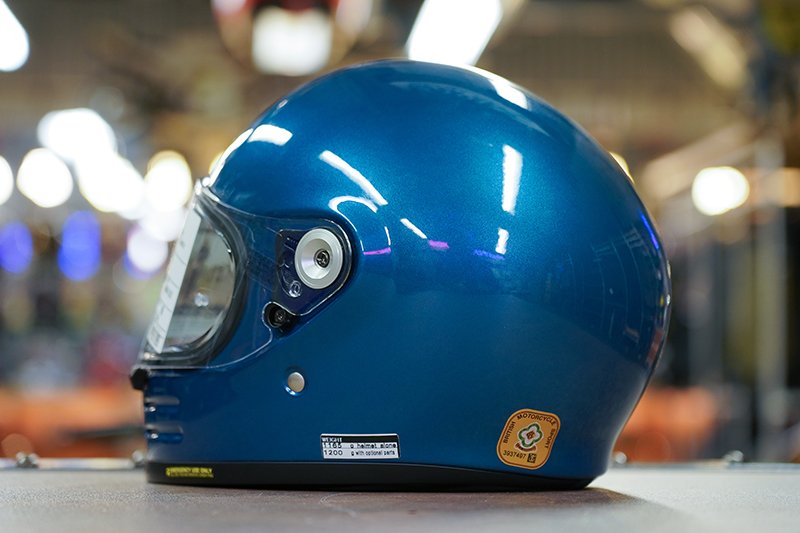
But arguably the more important element is the expanded polystyrene layer that lines the helmet. This is known as the eps, and it is similar to the stuff used in the packaging of kids toys, televisions and the like. When your head hits something hard with great force, the energy is absorbed by the eps. This slows down the speed with which the brain is catapulted across the skull. And this is crucial because it is when the brain rebounds from the other side of the skull that bruising can occur. And it is this bruising that can cause brain damage.
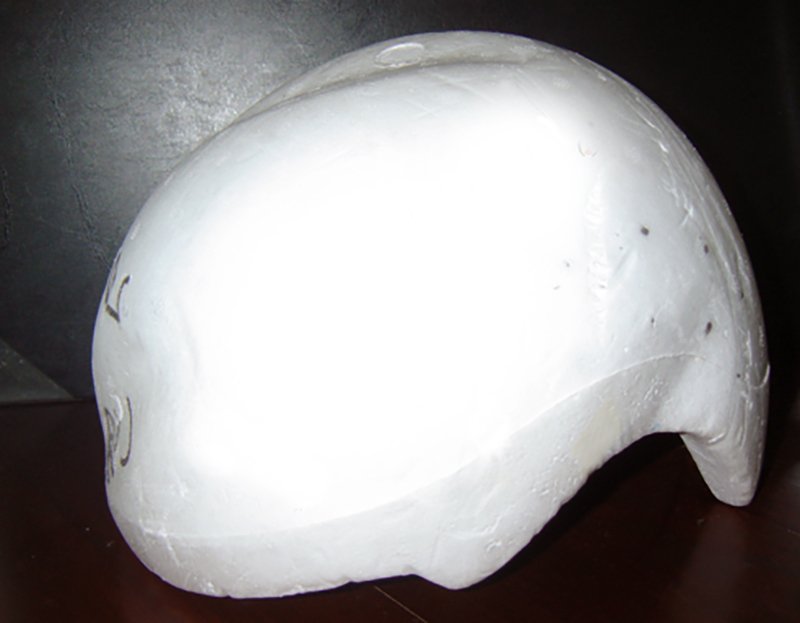
A damaged outer shell can render a helmet unsafe and therefore unusable. If it is cracked it will not allow the initial energy of an impact to be dissipated, and potentially it will lose its ability to resist the penetration of some form of sharp object. But the difficulty is in knowing whether the shell is too damaged to do its job. Now, in most circumstances where the shell is severely damaged, there will be tell-tale signs.
Stone chips that merely damage the lacquer are of no great consequence, and if all you have on your helmet are minor chips to the paint’s outer layer caused by knocking it against something when you were walking along with it in your hand, the helmet is still going to be able to do its job.
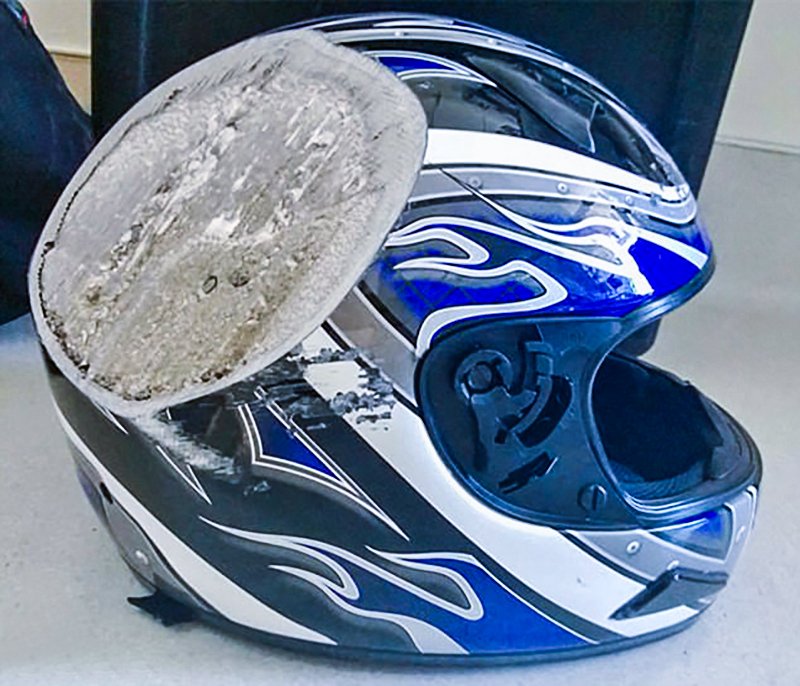
A chip in the paintwork that results from a more significant impact may, of course, be more concerning. The race teams use a very simple finger test to check the integrity of the shell. If you can feel any deformation in the shape or if you can feel the rough fibres that form part of the helmet’s laminate construction, then it’s kind of game over.
One can’t say that the eps is more important than the shell. Both the shell and the eps perform important functions, but in most accident situations it is the eps that will do most of the absorbing of energy.
Imagine hitting a piece of polystyrene with a hammer. You will compress the material, and this will leave a dent. And that is what is meant to happen with a helmet. It means that the eps has done its job. But in the area where the eps is compressed, it will no longer be as effective at absorbing energy. An eps has a one-time use. The material doesn’t bounce back. It doesn’t have a memory. Once the eps is compacted, it can not be relied upon to do its job a second time. If the eps becomes compacted, therefore, a helmet should be replaced. It doesn’t have to be, but it should be.
The problem is knowing whether the eps has been impacted, as it’s not always easy to see.
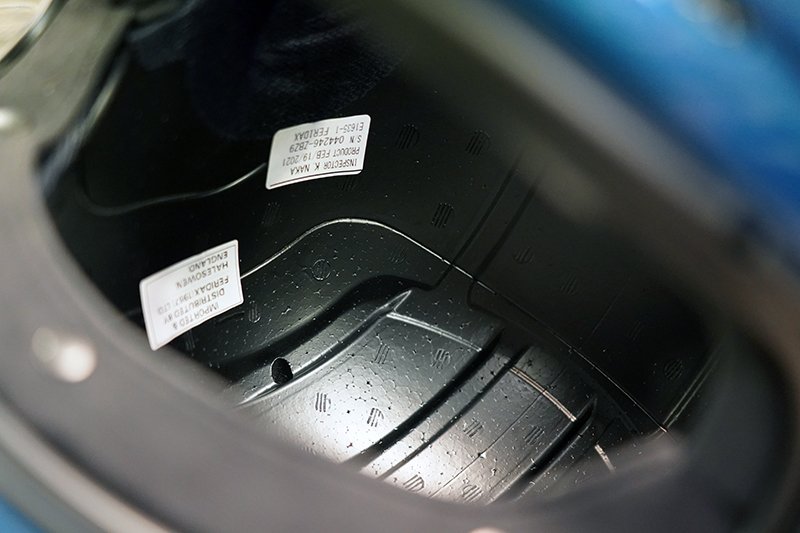
Some helmets, and certainly the better quality ones, have painted eps liners. Usually, this is in black or grey. And they are painted so that one can see if they have become deformed. If your skull is driven hard into the eps, it will deform and this deformation will cause cracks in the painted coating. So if you can see that there are cracks in the paint, then the helmet should probably be disposed of.
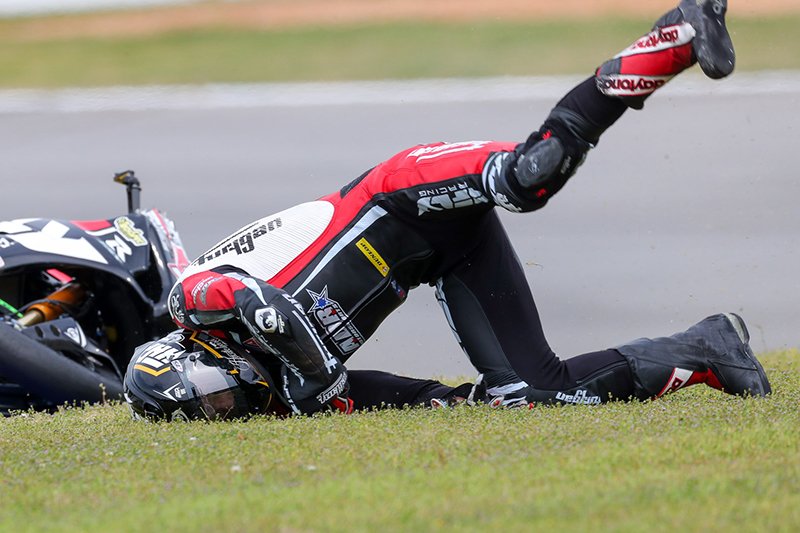
The problem is that the eps can also be deformed from the shell side, as opposed to the head side. Let’s say the helmet receives a heavy impact on a soft, grassy surface. The outer shell might no show signs of an impact, especially if it is a softer shell of the sort that you get with, say, a Shark helmet. Yet you could still have a compressed eps that would be invisible to the eye.

The question is what level of impact is going to cause this irreparable damage to an eps. And again, unfortunately, there’s no simple answer. We often get asked by someone ‘what should I do if I drop my motorcycle helmet. Now, dropping a helmet from four or five feet on to a soft surface is probably not going to render the eps ineffective. But falling off a bike, even standing still, where the helmet with your head in it hits the tarmac, or worse a sharp kerb, probably would.
There’s another issue that needs to be addressed with the eps; and it’s to do with its degradation over time. As we ride, we sweat, and this moisture is absorbed by the eps. As the eps dries out, it shrinks a little, and as it shrinks it hardens, making it marginally less effective at absorbing the energy of an impact. Now, it is deemed that at an average annual mileage of, say, 6,000 to 8,000 miles a year, the eps will shrink between three and five percent annually. And so there comes a point where the eps has shrunk so much that it is no longer sufficiently effective as absorbing energy. The thinking is that the average rider will reach this position after five years.
It is because of this that Shark Helmets told me that they are prepared to warranty the effectiveness of their helmets for five years. Once the five years is up, therefore, Shark think you should be changing your helmet. And after five years, Shark feel that their helmets cannot be guaranteed to protect you. When I was told this, I was as usual a little suspicious, but what was pointed out to me was that in South America, where the climate is much hotter, they only give their helmets a three year warranty, thus adding weight to their argument about degradation.
Unfortunately, you can’t just feel the eps with your fingers to detect whether it has hardened, because the hardening will often be deeper into the eps structure. Another way of looking at this issue is to look at mileage consumed rather than time. If the average mileage for a biker is somewhere between 6,000 miles and 8,000 miles, then it might be suggested that once a helmet has done between 40,000 and 50,000 miles it’s about time to change it.

And certainly some of our super-high mileage commuters will be looking to change their helmets after two to three years rather than five. These guys can be riding 20,000 miles a year, and I know some feel that, after two or three years, the liners have been eroded to a concerning degree.
For others, of course, a helmet that has done that many miles will have become, because of the shrinkage, unacceptably loose. Some might just think their helmets have become unacceptably smelly. And I can confirm that this can indeed be the case!
Okay, so we’ve looked at damage to the shell and damage to the eps, but how about a helmet that has been left in a box in a garage for six, seven, eight years or more? It may sound like a bizarre scenario, but it does happen. Some suggest that evaporation can still cause damage to the eps. Some might suggest that there could be degradation in the lamination of the shell. And whilst these outcomes are possible, a helmet that has sat in a box in a properly aired room for four or five years should still perform its primary role.
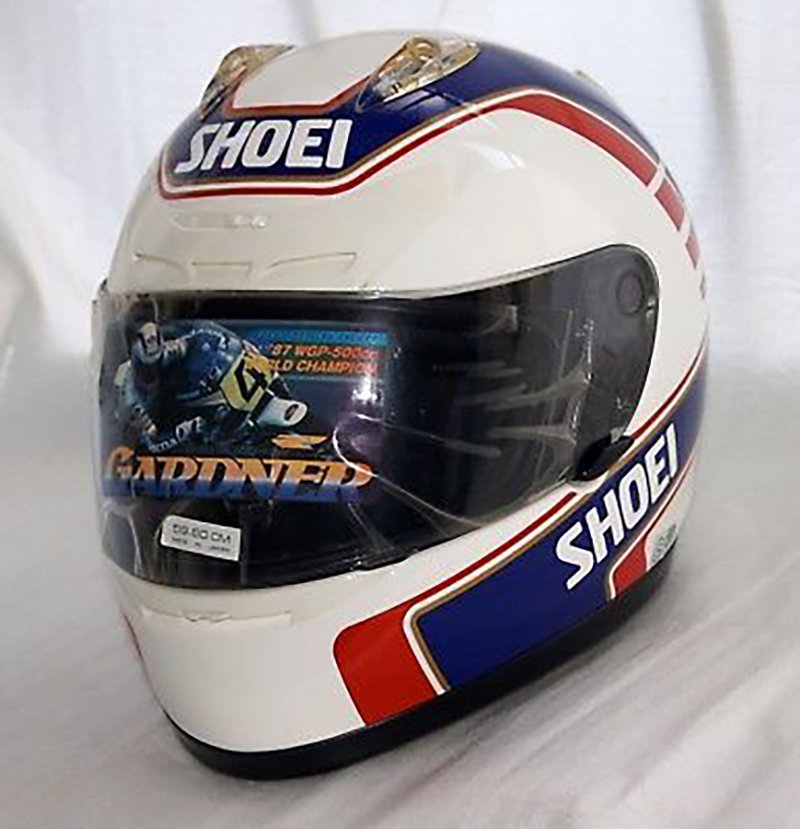
But there will come a point where it won’t; and nobody knows when that will be. It could be 10 years, or even 15 years. But my question is why would anybody want to wear a ten year old helmet? Why would anybody want to take that risk?
Over any ten year period, helmets will have improved. A ten year old helmet may allow you to ride a motorcycle, but it will have few of the creature comforts that we have come to expect. And why would you take the risk that it might not offer the necessary level of protection? This is your head we are talking about. Damage your brain, and it’s game over. No surgeon can repair it. If saving a few quid is that important to you, then save yourself some more money and take the bus!
Funnily enough, there is somebody. A company recently set itself up to offer motorcyclists a service whereby you could send your helmet in and have it laser inspected to see if the shell was damaged. The company uses a holographic process. A laser scans an area of the helmet to create a 3D image. This allows the company to detect any delamination of the fibres that form part of the composite shell. If there is damage to the shell, this process will identify it. And that is good.

But we are not convinced. No helmet manufacturer has been involved in evaluating or approving this service. The company’s view is that any delamination would render a helmet unusable. This may be the case, but it would be good to know that an Arai or a Shoei, or indeed any independent authority, agrees with this opinion. But of far greater concern is the fact that this company only has the ability to inspect the outer shell, and as any manufacturer will tell you, important as the outer shell is, it is the eps that bears the brunt of absorbing the energy of an impact.
I spoke with the company at length about this, and their view is that damage to the eps will always be detectable to the naked eye. What the company is relying on is visible deformation where the head leaves an imprint on the eps. But damage to the eps is not always visible to the eye. With painted eps liners, you might be able to see cracking, but not if it is not painted. There is also a scenario in which an eps can be deformed inside the shell and not be visible; maybe as a result of a heavy coming together with a softer surface like grass. And if the eps has hardened through shrinkage, you won’t necessarily be able to see anything at all.
And so what this company is doing is only half the job that is required. Their methodology has not been peer reviewed or approved by any third party. Yet they are telling people that out-of-date helmets are safe to wear based only on their ability to detect damage to the shell. This, we feel, is unacceptable. We don’t doubt that their test can detect what they say it can. But this service is simply not one that can tell you that your helmet is safe to ride in.
And so, right now the answer is ‘No’. There is nobody offering a credible, authoritative and authorised helmet inspection service. Sorry!
I have been open on this subject. As a biker, prior to becoming involved in the business, I had always suspected that the five year rule was one created by marketing people to encourage people to make another purchase. But that may just be the cynic in me, and even I have to accept that helmets both have a finite life and will not perform to the same standard once damaged.

I have spoken with lots of people in the helmet world about how to detect damage, and they have explained to me the issues, but even they admit that this is not a science. The people who work on the trucks looking after their racers’ helmets have told me what they do to inspect helmets and how, once they detect any damage to the shell or eps, they simply throw that helmet away.
Easy for them perhaps as the cost is not a major consideration. As a road rider, you may take a different view, and you may be prepared to take the risk that a damaged helmet is something you are still prepared to ride in. And if you don’t have another accident you will probably get away with it; that’s a personal decision.
But whilst, as bikers, we are all risk takers, here at Motolegends we personally feel differently about risk when it’s our heads we are dealing with. We are not talking here about the kind of accidents that can put you in traction for a couple of months, but rather the kind of accidents that can put you in a wheelchair for life!
I think, at times, bikers view the acquisition of their gear as a competitive sport. How little can I pay? How long can I make it last? And with any other item of protective wear, I can see how some people might find this fun, how they might see this as a challenge.
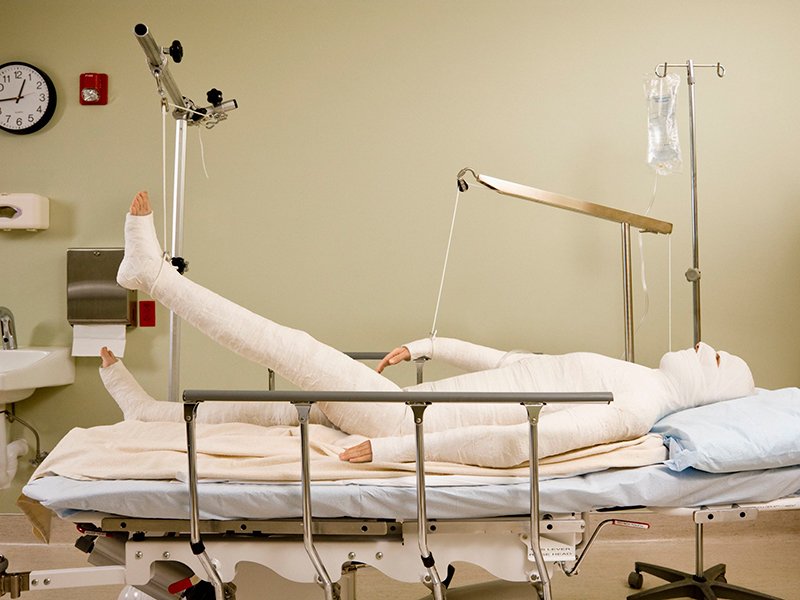
But it’s a dumb game to play with a helmet. Why risk a ten year old helmet or one that has been involved in a serious impact? Err on the side of caution, and there’s a chance that you might find yourself occasionally replacing a helmet that does not need to be replaced. Big deal; these things happen! You may think that by changing your helmet when you might not need to the man has won. And you like sticking it to the man! But this is not a zero sum game. If you win, the gain will be marginal; if you lose the loss could be huge!

The way we see it, £500 buys you a very, very good helmet; a helmet that is as good as it gets. It should last you five years of normal riding. £500 is not chicken feed, but break it down and that’s just £100 a year. Spend a moment to think about what £100 buys you. It buys you 15 gallons of gas. It buys you perhaps seven packets of cigarettes. It buys you 25 pints of beer. It buys you a meal for two at a pizza restaurant. Or it buys you the very best protection you can get for your head for a full 12 months!
And so what’s the problem, we ask?
If, having taken up motorcycling, which we all acknowledge to be dangerous, you really don’t think you should be spending £100 a year to protect those fast diminishing grey cells, then really I’d have to suggest that you haven’t thought it all through!
Are you asking what motorcycle helmet should I buy? Check this out: How to choose a motorcycle helmet.
Share this story
































































